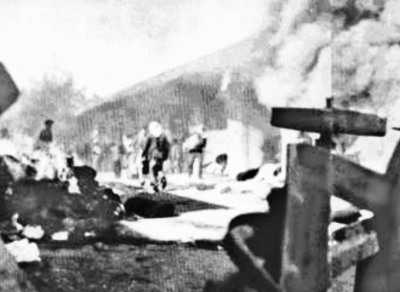Pages in Section 13

December 47 - Strikes and Riots
ii. Massacres at refinery and Balad al Sheikh
iii. Battle for Jerusalem
iv. Ben Yehuda Street bombed
v. Jewish Agency bombed
vi. A traffic policeman reminisces
vii. Battle for the Roads 1 - Jerusalem
viii. Battle for the Roads 2 - Mishmar ha Emek
ix. Battle for the Roads 3- Deir Yassin
x. Haddassa Hospital Convoy
xi. Battle of the Roads 4- Gush Etzion
 During an Arab three day strike against partition that began on December 1st and developed,especially in urban areas, into arson, stone throwing,rioting and bloodshed, the British section of the police found themselves without army backing. Both the British section of the police and the army had been forbidden to interfere in disturbances arose from the partition vote.
During an Arab three day strike against partition that began on December 1st and developed,especially in urban areas, into arson, stone throwing,rioting and bloodshed, the British section of the police found themselves without army backing. Both the British section of the police and the army had been forbidden to interfere in disturbances arose from the partition vote.
In Jerusalem, a mob of around 200 Arab youngsters aged between 10 and 20 surged up Mamillah Road from the old city. Police observed members of the Higher Arab Executive's official Youth Organisation attempting to deter other boys from stoning Jewish vehicles. They judged the rioting was more to do with strike-closed schools leaving hooligan youths at a loose end than with official Higher Arab Executive(HAE) policy and took action.
However, while their Commanding Officers were debating whether the incident arose from the partition vote, in which case they would have to obey instructions not to interfere, British troops stood by.
The police had insufficient numbers to hold back youths who broke into Princess Mary Avenue, smashed windows, looted shops and stabbed a number of people. One victim, Mr. Asher Lazar, Jerusalem correspondent of the Hebrew daily, "Haaretz", landed up in hospital,seriously wounded.
Haganah men, appearing in public for the first time, contributed to the chaos by firing over the heads of the rioters until the police arrested them.
A line of British Police eventually edged the mob back while more police blocked the top of Princess Mary Avenue with six fifty-gallon oil barrels and an armoured car. Members of the Jewish civic Guard kept Jewish civilians out of the street.
To Jewish disgust the police arrested no Arabs. Even when an Arab slapped the face of one policeman, the constable merely shoved back his attacker. This admirable restraint probably contributed to the lack of fatalities.
The mob, forced back from St Mary's Road, turned its attention to the Commercial Centre. Police in steel helmets and carrying shields, assisted at last by a few troops, moved into the area, while shopkeepers and their employees barricaded themselves in but not before hooligans had set fire, both inside the buildings and out in the street, to looted textiles. The civil fire brigade and the army fire engines rescued traders from burning buildings
Ambulances dashed though streets now devoid of pedestrians. The police of the Jerusalem Operational Patrol(JOP) drove their armoured cars through chaos into Jewish sections of Jerusalem carrying not only the less seriously wounded but also stranded workers and shoppers. A few Haganah appeared to help with the clear up.
The Palestine Post grumbled about the seeming lack of police impartiality but did print one tribute:
Drivers of the Hamekasher Bus Company have asked The Palestine Post to express their thanks to the British Police inspector and his men who looked after five buses and passengers on their way to Talpioth and Mekor Haim last night. The police accompanied the convoy of buses through Zone A and then rescued the passengers when attacked by an Arab mob.
On the second day of the strike a plume of black smoke from the Arab Rex Cinema showed the Irgun were adding their own piastre-worth to Jerusalem bedlam.
Until the Haganah informed them that their services were no longer required police introduced a convoy system from Tel Aviv to Jerusalem with armoured cars escorting buses and lorries. They also escorted the convoys that took food into the old city Of Jerusalem and brought out several families.
Local British authorities officially dismissed these incidents as individual events. However on Dec 4th, alarmed by violence in Palestine, the government in London approved a plan instructing the army to separate Jews from Arabs wherever possible, and to transfer people wishing to move to areas where their nation had a clear majority.
Consequently,in the following weeks the British made no effort to stem the mass flight of Arabs from the mixed neighborhoods of Jerusalem’s southwest Jerusalem. They would have liked the Jews to leave areas where Arabs predominated such as the Old City or areas that could only be reached by passing through an Arab area such as Mt Scopus, but Haganah had issued an order that all Jews were to remain in their houses regardless of the danger.